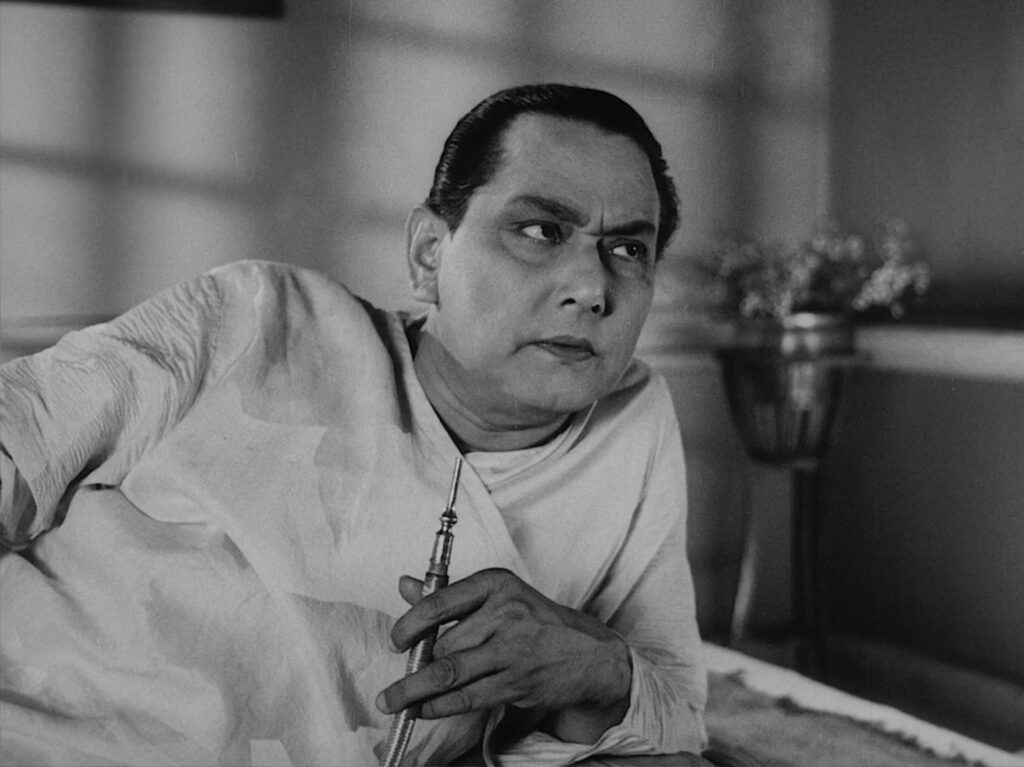
The Music Room
1958, directed by Satyajit Ray
At the end of The Music Room when the chandelier flickers out in Huzur Biswambhar Roy’s palace, the life of the old man flickers out too, and by extension so does the rule of the old aristocratic class in modern Bengal. The chandelier is always equated with Roy, along with the traditions and social class he represents. It’s the first image in the opening titles, and Roy speaks of his son Khoka as the “wick” keeping the family flame burning. Toward the end, when Roy has spent four years sequestered in the upper stories of his palace, the chandelier is covered in cobwebs, summarizing the faded glory of the old upper class.
The opening shots single out the chandelier swaying like a pendulum, drawing nearer and nearer in the darkness. Normally a chandelier should not move at all except when its candles are replaced. Coupled with the intense music there is something menacing about its movement, suggesting the cruel passage of time and approaching death. If it’s strange to see a chandelier swinging so vigorously, what follows is even stranger. The next shot introduces Huzur Roy lounging on his rooftop terrace, but after drawing nearer to the chandelier the camera now reverses direction, receding from Roy’s face. The strange thing is how absolutely immobile he is – neither his eyelids, nor his facial muscles, nor the hand holding his cane flickers a millimeter. Only a close examination of his larynx and upper chest reveals that he is breathing; otherwise it would be hard to believe the picture is anything but a still photograph. Finally, after his manservant Ananta hands him the hose of a hookah, Roy’s body and mind slowly come to life.
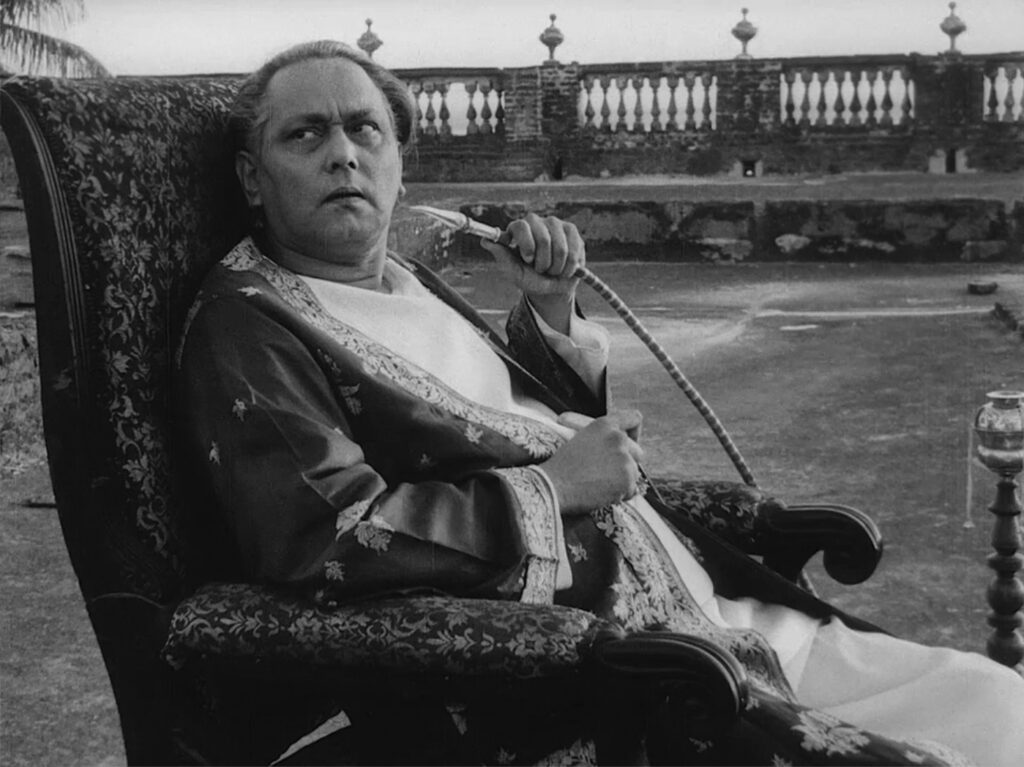
Roy and his kind may be equated with the chandelier, but the cut from the chandelier to his face draws a contrast. One approaches, the other recedes; one moves when it’s not supposed to, the other is unnaturally still. There is no contradiction however – this contrast expresses Roy’s resistance to his own fate. While his end approaches rapidly, he imagines he can carry on as he always has.
As we will shortly hear in the dialogue with Ananta, Roy never leaves his house to go anywhere. Throughout the film, physical movement represents to him the horrors of change, of advancing history, of the imminent end to his prestige. The film is therefore built around movement and the lack thereof. The entire picture is confined to Roy’s palace and a small part of the surrounding plains. Twice Roy refuses to attend musical performances at the home of his neighbor Mahim Ganguly, a lower caste businessman, the son of a usurer, whose rising wealth and status threaten to usurp the Roy family’s long established preeminence. Roy also refuses, on the weakest of pretexts, to accompany his wife and son on the trip to Narayanpur.
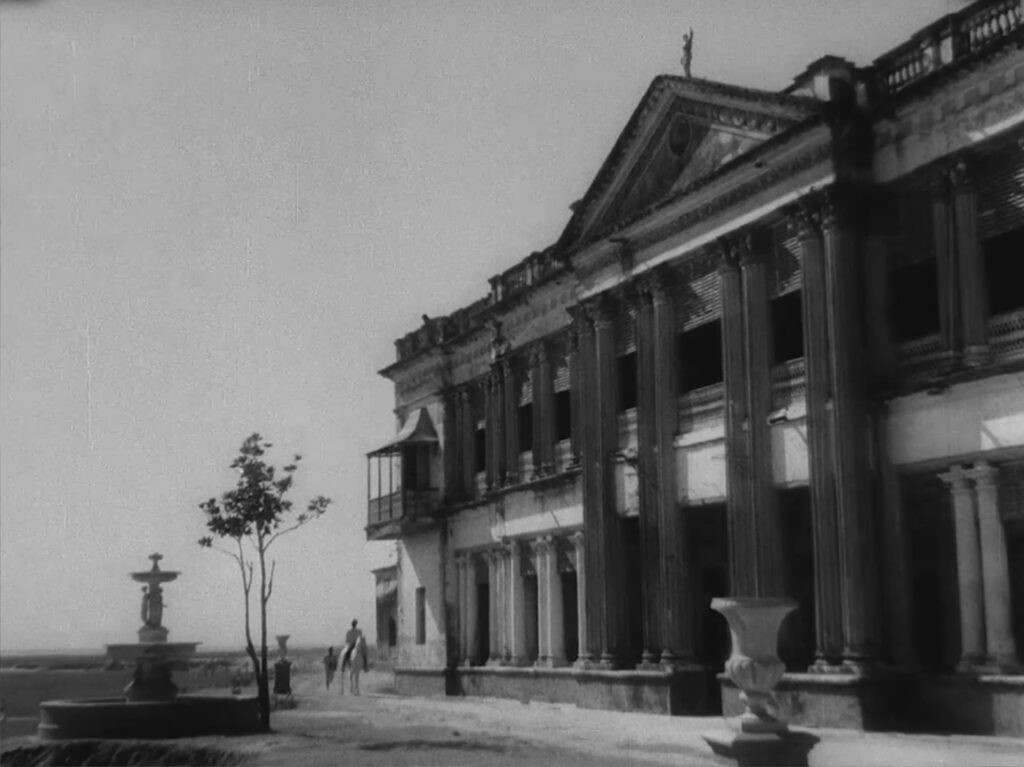
Roy’s fear of movement is justified halfway through when a whirlpool kills his wife and son on their return from Narayanpur. While Roy monitors the storm from his bedroom, the wind tips over an ivory boat, echoing their death. Movement proves fatal for them, just as it does for him when he falls from a galloping horse at the end. Not coincidentally, it’s a boat dragged ashore that causes the horse to rear up and cast Roy to the ground. Anything that represents movement, including horses, boats, and any kind of vehicle, proves an ill omen for Roy.
When Roy goes downstairs for the first time in four years to survey the land outside, another type of vehicle awakens him to the unfortunate changes he’s missed in his absence. A Ganguly & Co. freight truck tears past, raising a cloud of dust. Roy’s upstart rival has gained on him, moving ahead while the aristocrat remained fixed. The sight of the truck provokes Roy, who resolves to assert his superiority first by sending a dressed-up elephant to deliver a gift for Ganguly’s son’s initiation ceremony, and then by upstaging Ganguly at a final lavish musical gathering that depletes most of Roy’s remaining assets.
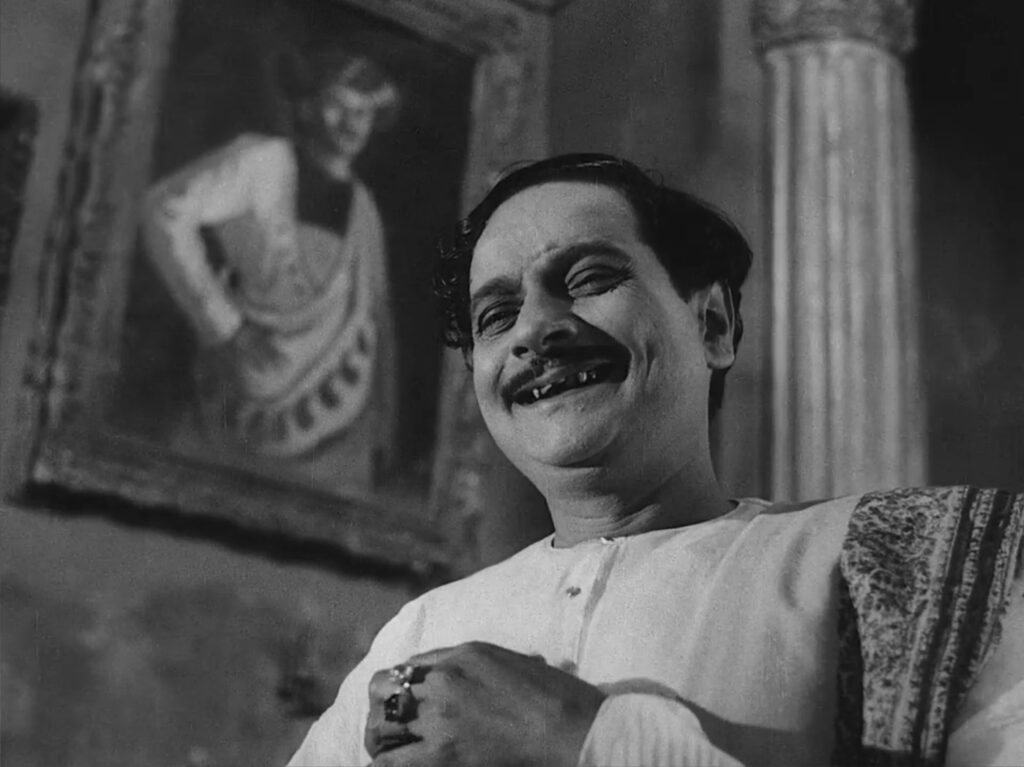
The last performance in Roy’s music room begins, like the two previous, with a cluster of seated musicians playing and singing. Suddenly the dancer Krishnabai bursts onto the floor with a vivacious dance. Roy glories in the spectacle, yet this flourish of movement proves the capstone to his family’s long reign. The scene climaxes when Ganguly motions to pay the dancer, and Roy decisively halts the movement with an abrupt hooking of his cane. The old guard has momentarily and symbolically halted the ascent of the rising class, but it’s a pyrrhic victory because Roy has spent his last capital.
Huzur Roy’s preference for fixity over movement manifests itself also in the music room’s gallery of portraits, enshrining the majesty of his lineage from his great-great-grandfather to himself. He looks up at the paintings with solitary pride, but when a spider scampers across his own likeness, disturbing the stillness, he shoos it off with the rage of a man who feels mocked. Like the cobwebs on the chandelier later on, the spider and its movement signal the decay of his status.
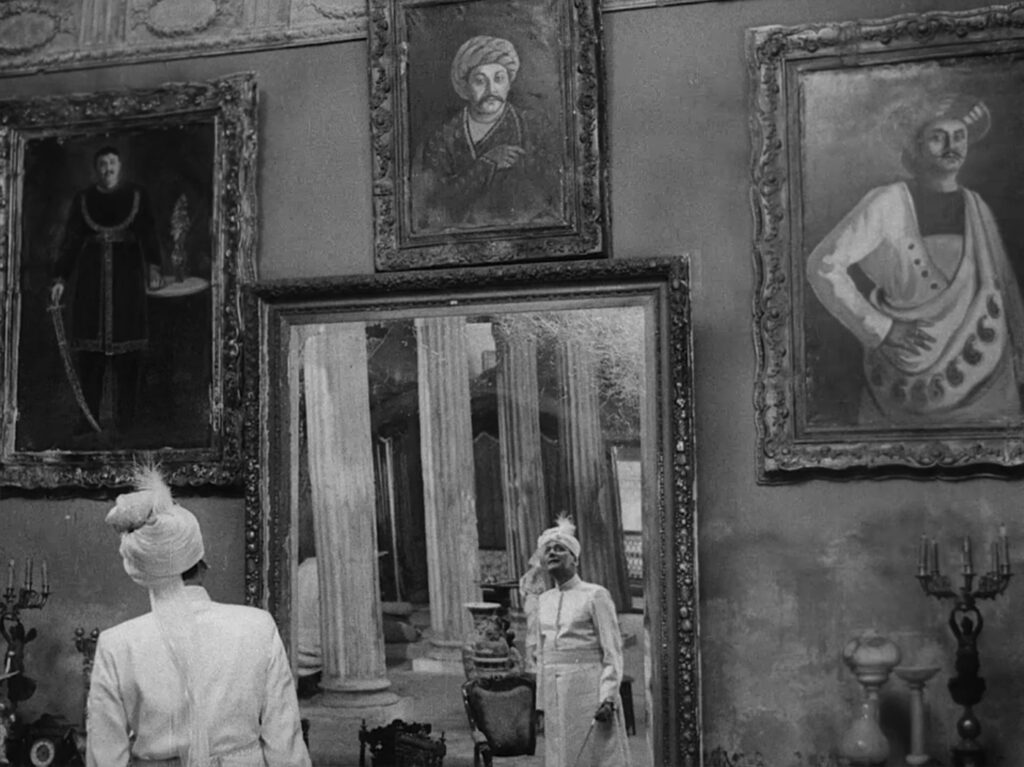
When Huzur Roy shows off the portraits to Ananta and toasts his ancestors, it’s not insignificant that he switches to English. The old aristocratic order was a component of the British Raj, the colonial reign over the Indian subcontinent that lasted from 1858 to 1947. The name “Roy” originates in an honorific British title for native Indians. The palace itself, though adorned with Indian artworks and filled with traditional Indian music, is designed in a distinctly European architectural style, and the family portraits are also painted in a European style. Although India had been independent for over a decade when The Music Room was made, nobility is still represented by a close connection to English culture. Even Ganguly pays homage to the old colonizers, inviting British officials to his son’s ceremony and rehearsing pompous British music for their arrival.
The Music Room‘s portrayal of waning nobility is not merely a picture of changes occurring in mid-20th century India, although it certainly is a wonderfully drawn portrait of that specific era. Roy’s aversion to movement is emblematic of conservatism generally. The conservative tendency is essentially a wish for the world to remain unchanged, either from its present form or from an idealized past. By exposing the folly of Roy’s unquestioned attachment to the status quo, the film criticizes conservative thinking at its roots, but it is no less critical of Ganguly’s alternative. Ganguly is a crass and ill mannered proponent of progress and social change, even less sympathetic than Roy. The film is fundamentally a critique of pride, revealing how the fault manifests itself both in conservative habit and in social upheaval.
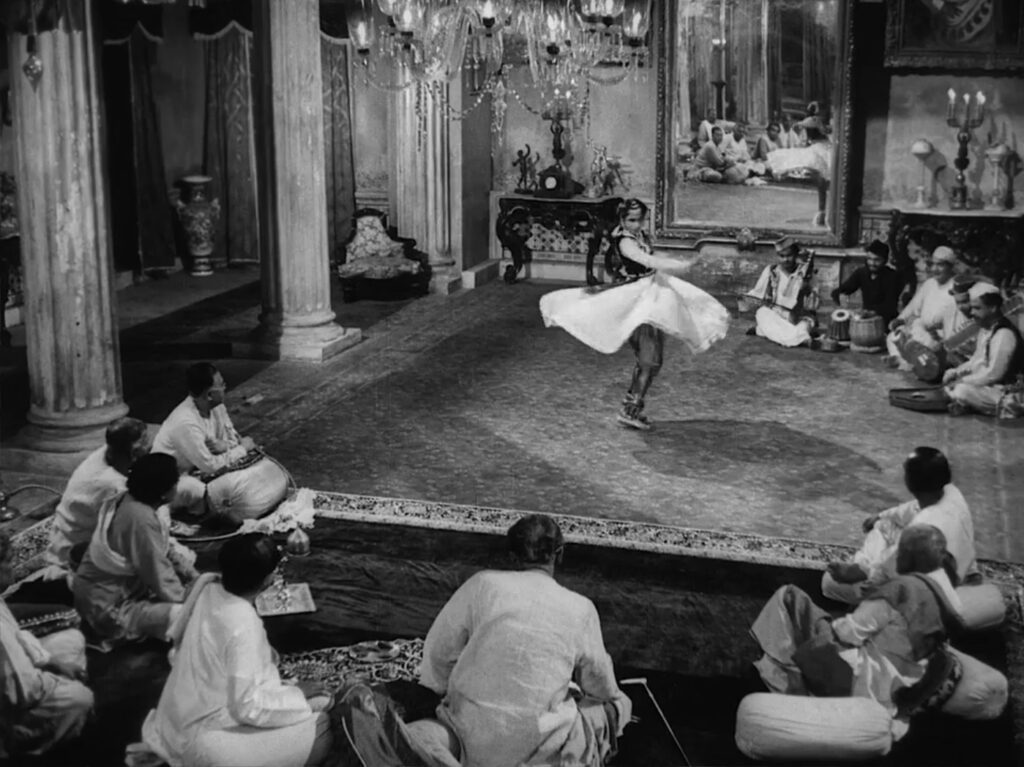
Most of The Music Room‘s first half is a flashback, tracing in 44 minutes how Roy has become so immobile that he won’t leave the upper rooms of his palace. In the flashback Ganguly had come to Roy as a supplicant, his body language submissive, while Roy had treated him with measured contempt. Afterward, in the present tense, Ganguly arrives by car and remarks on the decline of the palace. It’s now his turn to show pride, and he takes every opportunity to do so up to his attempt at paying the dancer.
The pride in each character – whether Roy contemplating his noble lineage or Ganguly taking satisfaction in his new status – is a kind of residue, something inherited from the past. Roy carries it down from his ancestors unchanged, whereas Ganguly’s long-wounded pride, rooted in class and caste disparities, rises to assert itself. Once we understand the extent to which pride tends to be inherited, we may realize how little it actually belongs to us, or to whoever holds it. At the end of The Music Room, shortly after boasting to himself about his “noble blood” in the portrait gallery, Roy spills that same blood into the earth. He was only a receptacle, and any concept of innate nobility should look now like an illusion.
CONNECTIONS:
Late Spring – Commentary on humans’ innate resistance to change
Pather Panchali – Spider at the end signifying decay or corruption
The Servant – Lower class competing with and upstaging the upper class
Antareen – Victorian-era mansion characterizing the faded glory of Indian aristocracy from the Raj